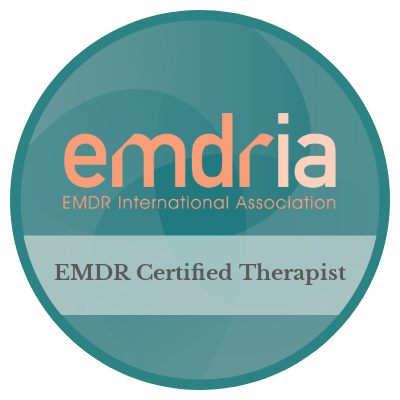What is EMDR Therapy?
 Eye Movement Desensitization and Reprocessing Therapy (EMDR) is a therapy treatment method that started in the late 80s-early 90s. It aims to resolve emotional difficulties caused by disturbing, upsetting, or frightening life experiences. These can be big events such as abuse or witnessing violence or more common events such as divorce, school problems, peer difficulties, failures, experiencing hurricanes or other storms, and family problems. When an upsetting, scary, or painful experience happens, the memory can either process or it may remain “stuck” in the mind. When it remains stuck, the experience can have a negative impact on the person’s functioning.
Eye Movement Desensitization and Reprocessing Therapy (EMDR) is a therapy treatment method that started in the late 80s-early 90s. It aims to resolve emotional difficulties caused by disturbing, upsetting, or frightening life experiences. These can be big events such as abuse or witnessing violence or more common events such as divorce, school problems, peer difficulties, failures, experiencing hurricanes or other storms, and family problems. When an upsetting, scary, or painful experience happens, the memory can either process or it may remain “stuck” in the mind. When it remains stuck, the experience can have a negative impact on the person’s functioning.
Imagine that you are trying to run a program on your computer that is necessary for your job. You click on it and it starts to run, but then the computer freezes. Each time that you try to run it, the hardware of your computer is the same and it gets stuck, unable to process the request fully, causing the glitch. You need this program though and your options are to work around it or keep trying. If you work around it you aren’t able to perform up to your job standards. If you try over and over again you just get the same results and it reinforces the problem as you get more upset. This is essentially what is happening in your brain with a stuck, unprocessed memory.
Stuck memories are triggered easily and bring up the same emotions, responses, and negative beliefs that occurred during the original event. These memories may feel like they are being relived through nightmares or flashbacks, or even by experiencing similar events over and over. Even if you don’t know what may be causing your current problem, it could still be rooted in a past memory. In fact, this is often the case for many people.
EMDR Therapy combines elements of several other well-established clinical models together with “bilateral stimulation” to help the brain reprocess the traumatic memories by facing them. Bilateral stimulation refers to the use of alternating, right left tracking that may take the form of eye movements, tones delivered to each ear, or tactile stimulation. EMDR Therapy helps to process the troubling thoughts, feelings, and memories and as a result strengthens feelings of confidence, calmness and mastery so that a person can return to their normal developmental tasks. The memories will still be there, but the belief the person has about themselves due to the event will change to be neutral or positive and the emotional intensity will diminish as will the symptoms experienced due to them.
How is EMDR Therapy done?
In EMDR Therapy we do not go straight into processing negative life events. We must first assess to make sure that the approach will be a good fit for you and the problem(s) you are hoping to resolve. We also want to make sure that you have all the skills necessary to be able to process the information that might come up. We start first with working on skills that will help cope with feelings that are brought up in counseling during the process. Once those skills are mastered and the clinician determines you are ready to begin processing the difficult material that may come up, the trauma processing can begin.
 We start first with identifying the current situation that is causing issues in your life and the thoughts and feelings surrounding the situation. We will then use that information to try to find the earliest memory that is related to this event and will start our trauma work at the earlier memory. The reason for starting at the earliest (related) memory is that the memories all become connected with the earliest being the root. If you were to pull up a weed and the root remains in the ground, the weed is likely to grow back in a short time. You must get the weed down at the root to prevent that same one from growing back. Trauma work is very much the same in that we have the best results when we process the root memory which affects all of the more recent memories that are related. Sometimes we would have never even guessed that the root memory is even connected to the current issue at all!
We start first with identifying the current situation that is causing issues in your life and the thoughts and feelings surrounding the situation. We will then use that information to try to find the earliest memory that is related to this event and will start our trauma work at the earlier memory. The reason for starting at the earliest (related) memory is that the memories all become connected with the earliest being the root. If you were to pull up a weed and the root remains in the ground, the weed is likely to grow back in a short time. You must get the weed down at the root to prevent that same one from growing back. Trauma work is very much the same in that we have the best results when we process the root memory which affects all of the more recent memories that are related. Sometimes we would have never even guessed that the root memory is even connected to the current issue at all!
Once we have our timeline established we can start using the bilateral stimulation (eye movements, tones, or tactile stimulation) to help the brain process the memory in a healthy manner. We will bring up certain information associated with the memory and use the bilateral stimulation which will help keep you partly in the present moment and therefore helps you to feel safe while your brain processes the memory in the way it needs to. As the memory is processed, the thoughts and beliefs about it will begin to change. You may not feel positive about the traumatic event but you can have a sense that you can leave it in the past and that it no longer controls you, your behaviors, or how you see yourself. Once we have worked through the earliest memory we will begin to work through more recent memories until you have processed all memories related to the present issue. Many times, processing the earliest memory can have a positive impact on the more recent ones, making them quicker and easier to process.
After the negative memories are reprocessed in a healthy manner we move on to positive beliefs about yourself and helping you to identify more strongly with them. We can even work on possible future situations that could arise and help you imagine using new skills to navigate them successfully.
How Does EMDR Therapy Work?
It is not entirely clear at this time how EMDR Therapy works to help the brain reprocess memories. Researchers are continuing to investigate to be able to answer this question with more certainty. Some researchers believe that EMDR therapy works similarly to dreaming or REM (rapid eye movement) sleep, which is another time that we know our brain processes information. It is thought that the bilateral stimulation may help both hemispheres of the brain communicate to one another and therefore activates the body’s natural healing mechanisms. What we do know is that this therapy helps all of the information (sights, sounds, smells, tastes, emotions, sensations, and thoughts/beliefs) to be accessed together and metabolized.
For more information you can visit the EMDRIA (EMDR International Association) website.
Jessica Stebbins, LMFT is a Certified EMDR Therapist
